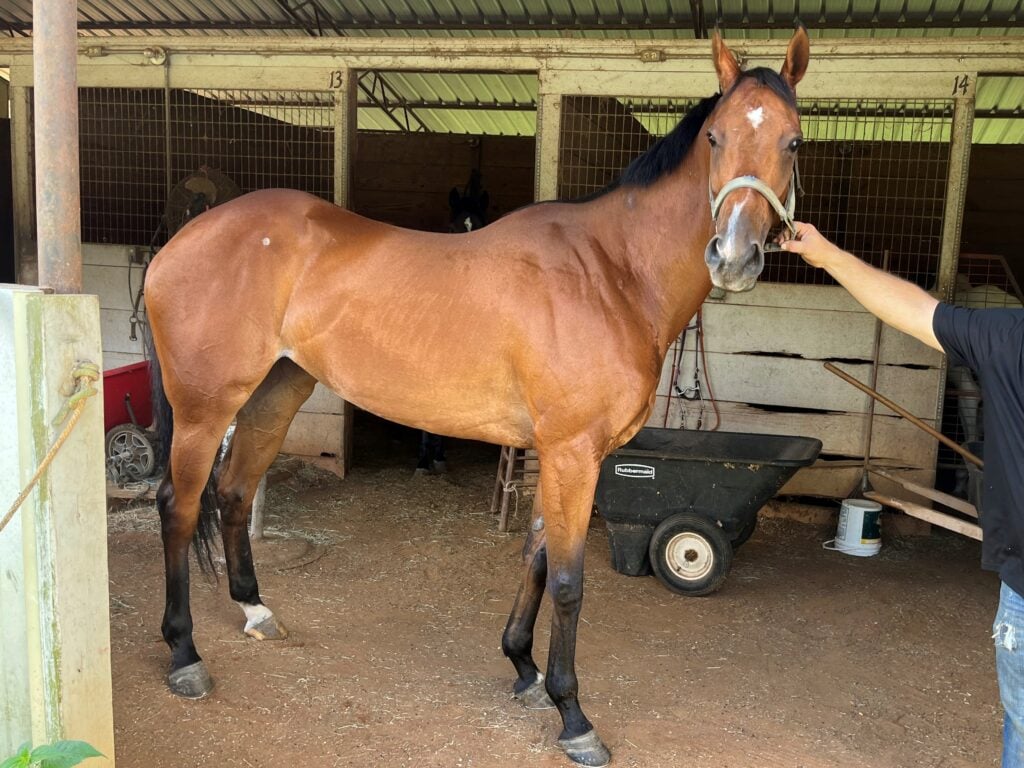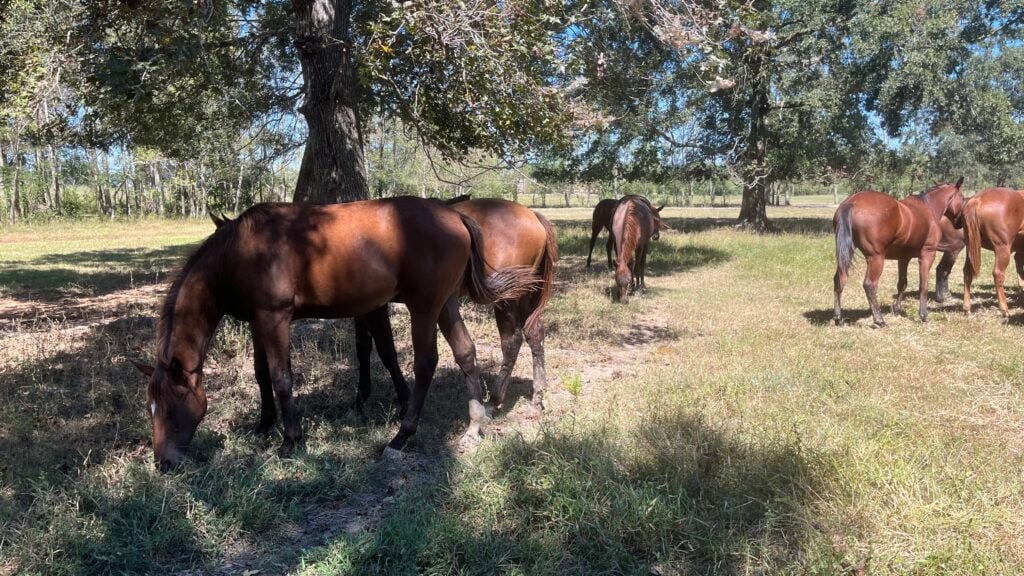Last updated: July 20, 2023
When I told my friend about the five young horses we bought, he asked me what gender they were. When I told my friend that three of the horses were fillies, he then wondered why they’re called “filly” instead of “mare?”
Young female horses less than four years old are called “fillies,” while their older counterparts are known as ‘mares.’ The term “broodmare” refers to female horses used for breeding purposes; when referring to them as a mother, they are dams.
What do you call a girl horse? A filly, a mare, or a broodmare? This article will cover the different terms for baby, juvenile, and adult female horses. Learning these terms will help you better understand the horse world – whether you’re just getting started or have been around horses your whole life.

What do you call a female horse?
When someone asks you what you call a female horse, do you know the answer? A lot of people don’t. In fact, many people think that there is only one name for a female horse – mare. But that’s not true. There are actually several different names for a female horse. So, what are they?
A filly is a young female horse not yet old enough to be called a mare. Mares are adult female horses. If you have ever seen a horse race, the young horses racing are usually called colts or fillies.
Fillies are often smaller than colts, but they can run just as fast. Some of the most famous racehorses in history were fillies. Ruffian was one of the most successful American racehorses of all time, and she was a filly. Do you have any favorite fillies?
Filly is the term that can be used for any young female animal but is most often used for horses. A colt is the male equivalent of a filly. Mares are used for riding, racing, and breeding. Stallions are the male equivalent of mares.
Broodmares are mares that are used primarily for breeding purposes. They may be kept at stud farms and used principally to produce offspring, often sold as racehorses or for other equine events. Some broodmares are also kept as pets or companion animals. Geldings are the castrated male equivalent.

What is a baby girl horse called?
So what do you call a baby girl horse? A filly, weanling filly, and yearling filly are all proper names for a girl horse under two. Note: A pony is not a baby horse.
- Filly– This term applies to all female horses under four years old, including babies.
- Suckling filly– A suckling filly is a female horse still sucking milk from its mother.
- Weanling filly– A baby girl horse that is no longer nursing.
- Yearling filly– A girl horse between one and two years old
Baby horses are so adorable! I’m sure you’re wondering what to name yours. We decided on names for our colts but are still trying to choose the perfect name for our girl horses.

What are mature female horses called?
Do you know what mature female horses are called? If not, don’t worry – you’re not alone. This is a question that many people don’t know the answer to because of the different monikers that describe them.
A mature female horse over four years old is called a mare. The term “mare” comes from the Old English word meare, also used to describe a female horse. Most mares are used for the same purposes you can use a male horse, riding, working, and breeding.
A broodmare is a mature female horse that is used for breeding purposes. She is usually an older horse that’s retired from use in other equine activities. For example, a retired racing mare used for breeding purposes is called a broodmare.
However, we’ve owned a few broodmares that we continued to use for pleasure riding even when they were pregnant. So, it’s not like all they can do is reproduce.
The mother of a foal is called the dam. This is usually an adult female horse that has been bred before and has given birth to at least one foal. A dam can be any age, but she is typically an older horse.
- Mare: Mature female horse at least four years old
- Broodmare: A female horse used primarily for breeding
- Dam: The mother of a foal.
What do you call a baby horse?
When it comes to baby horses, they can be known by various terms. Some of the most common names are foal, colt, and filly. But did you know that there are many other names for baby horses?
The term “foal” is the most common name for a baby horse. It comes from the Old English word “fola,” which traces to the German Fohlen, from PIE *pulo, which means “young of an animal.”
Foals are typically born in the early spring, and they weigh around 100 pounds at birth. A colt is a male foal, while a filly is a female foal. Other terms used to describe baby horses include suckling, weanling, and yearling.
Suckling is a term used for foals still nursing from their mother. However, I don’t hear this term often used. Once a baby horse stops nursing and starts eating independently, it is considered a weanling.
Foals typically stop nursing between four and six months old but may be weaned earlier or later, depending on their size and development. Interestingly, from weaning to when a young horse turns two years old, it will typically double its weight.
A yearling is a horse that is between one and two years old. So, a baby horse can be called a foal, colt, filly, suckling, weanling, or yearling.

Are Female Horses Easier to Ride Than Male Horses?
There is a long-standing debate about whether female horses are easier to ride than male horses. Some people believe that there is no difference, while others think that one gender is inherently easier to ride than the other.
I believe that, in general, female horses are easier to train and ride than male horses. Females are typically smaller and more gentle than males, making them better suited for beginners. However, I currently have a young filly that is meaner than any colt I’ve ever been around, and when you mount her, she is a handful.
Some of my friends claim male horses train and handle just as easily as female horses. They contend that gender is not a factor in riding ability. Instead, they believe that it is all about training and experience.
So, who is right? Are female horses really easier to ride than their male counterparts? I think horses are individuals, and there is no definite answer. It really depends on the horse itself.
Some female horses may be more skittish and more challenging to control than some males, while others may be gentler and easier to ride. The same goes for males – some may be more difficult to ride than others. In the end, it comes down to the individual horse and its rider’s abilities.

Below is a YouTube video of a mare and her filly.
FAQs
What do you call horses at different ages?
A young horse under one is called a foal. A male horse under four is called a colt, and a female horse under four is called a filly. After four years old, all horses are simply called horses regardless of gender.
What do you call male horses?
The word “stallion” is often used to describe a male horse, but there are actually several other words that can be used. These include colt, gelding, stud, and stallion.
Are male horses more aggressive than females?
In general, stallions are more aggressive than mares and geldings. However, horses are individuals, and there are many calm male horses and some very aggressive mares and geldings.

About the Author: Miles Henry
Lifelong Horseman | Racehorse Owner | Published Author
Miles Henry brings over 25 years of hands-on experience training and owning Thoroughbred racehorses. Raised with Quarter Horses and Appaloosas, he’s spent a lifetime learning from horses—on the track, in the barn, and in the field. Today, he runs a small but successful racing stable in Louisiana and shares real-world insights on HorseRacingSense.com, helping horse owners, fans, and bettors navigate the sport with confidence.
📚 Books: View Miles’s books on Amazon »
🎧 Podcast Guest: Animal Tales Ep. 32 |
YouTube Interview
📩 Newsletter: Sign up for racing tips and horse care advice »
🔗 Follow Miles:
Twitter |
Facebook |
YouTube


